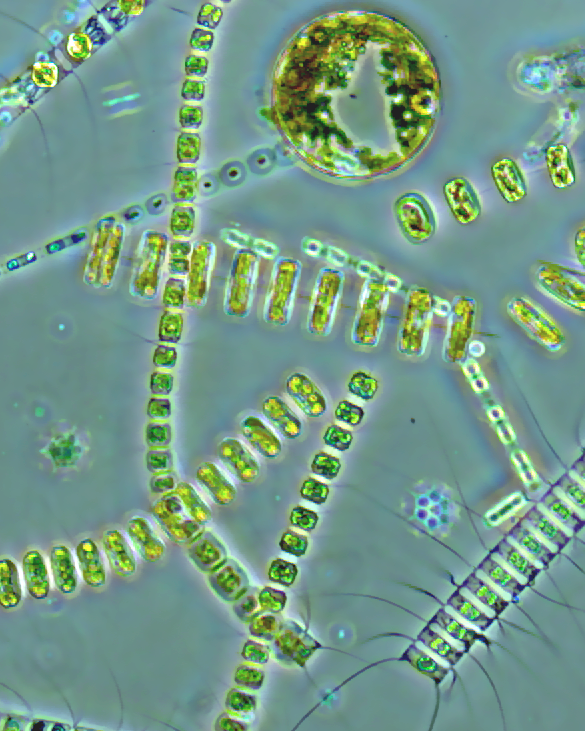Diatoms generate approximately 40% of all primary production in marine habitats and can be found throughout the world’s oceans. The Rynearson lab uses a variety of techniques, including DNA fingerprinting, to examine the extent of genetic diversity within species and to understand how that diversity is subdivided over space and time. Because planktonic diatoms drift with tides and currents they have a high potential for dispersal and gene flow. Our research focuses on the essential questions of if and how populations of planktonic diatoms are connected at local, regional and global scales. Connectivity among populations can influence a species’ ecology, adaptive potential, evolutionary longevity and ultimately speciation potential. We examine how local populations are connected to each other on regional scales and how regional dynamics connect to global-scale biogeographies. In addition to genetic variation, we are also interested in physiological variation and how this enables populations to adapt to different environmental conditions, including those related to climate change. This research has been funded by the National Science Foundation. Click here for a list of related publications.
ADAPT: Antarctic Diversity Among Plankton and their Transformations
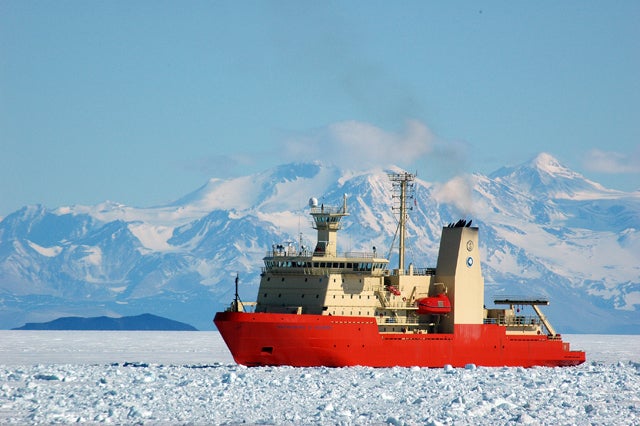
Follow our research cruise Dec 19, 2016- Jan 23, 2017
On this Antarctic cruise, we’ll study how plankton adapt to new environments, particularly those driven by climate change. We’ll measure the genetic diversity of diatoms (a planktonic algae with key roles in marine food webs and biogeochemical cycles) and examine how diatoms respond to changes in water temperature and ocean acidification. This cruise is the first step in a 4 year collaborative project between oceanographers and evolutionary biologists.
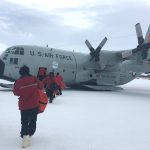 The Great Escape. - This cruise has been so wonderful from beginning to end – the science went swimmingly and the team was great. The crew and support staff on the ship made our jobs go smoothly, and it’s a treat to be able to focus on doing the science without having to worry about all the other stuff […]
The Great Escape. - This cruise has been so wonderful from beginning to end – the science went swimmingly and the team was great. The crew and support staff on the ship made our jobs go smoothly, and it’s a treat to be able to focus on doing the science without having to worry about all the other stuff […]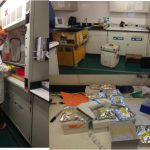 Breaking down a ship-based lab - The last three days have been a frenzy of activity as we break down our ship-based laboratories and prepare samples for shipping. We’ve been packaging over 2,000 diatom cultures with care so that they’ll return to Rhode Island alive and well. Meanwhile, we’re stowing away all of our important sea-going instruments and digitizing our datasheets. […]
Breaking down a ship-based lab - The last three days have been a frenzy of activity as we break down our ship-based laboratories and prepare samples for shipping. We’ve been packaging over 2,000 diatom cultures with care so that they’ll return to Rhode Island alive and well. Meanwhile, we’re stowing away all of our important sea-going instruments and digitizing our datasheets. […]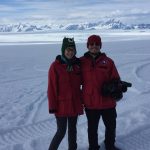 The Adventures of Watson - Today’s post is contributed by Greta Shum, who is part of the multimedia team on our cruise. It’s the Adventures of Sherlock Holmes. That’s what it’s called. Not The Adventures of Sherlock Holmes and Watson. But I am on an adventure, following after this detective as he teases out the mysteries of the Southern Ocean. […]
The Adventures of Watson - Today’s post is contributed by Greta Shum, who is part of the multimedia team on our cruise. It’s the Adventures of Sherlock Holmes. That’s what it’s called. Not The Adventures of Sherlock Holmes and Watson. But I am on an adventure, following after this detective as he teases out the mysteries of the Southern Ocean. […]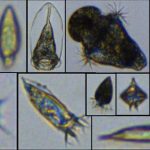 Tiny Predators in the Ocean - With the cruise coming to an end, and with everyone busy wrapping things up, it’s easy to miss a tiny rack of tubes nested in the corner a cold incubator. The tubes contain live samples of microscopic plankton collected from some of the sites we have visited. The difference – the collections in these tubes […]
Tiny Predators in the Ocean - With the cruise coming to an end, and with everyone busy wrapping things up, it’s easy to miss a tiny rack of tubes nested in the corner a cold incubator. The tubes contain live samples of microscopic plankton collected from some of the sites we have visited. The difference – the collections in these tubes […]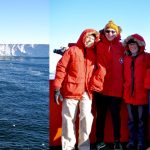 The Great Ice Barrier - After an incredibly windy night at sea, we’ve reached the largest ice shelf in Antarctica, the Ross Ice Shelf. This massive piece of ice spans 188,000 square miles (487,000 km2) and rises about 160 ft (50 m) above the water surface. If we were to look below the surface, we would find another 1,600 ft […]
The Great Ice Barrier - After an incredibly windy night at sea, we’ve reached the largest ice shelf in Antarctica, the Ross Ice Shelf. This massive piece of ice spans 188,000 square miles (487,000 km2) and rises about 160 ft (50 m) above the water surface. If we were to look below the surface, we would find another 1,600 ft […]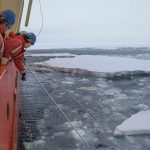 Ice hunting - Microbial populations in the Southern Ocean can live in the open water, but they can also live in the ice itself, and today we collected ice samples so that we could check whether the diatoms ice and in the water were different. After getting our choice pieces of ice up on deck, we sealed them […]
Ice hunting - Microbial populations in the Southern Ocean can live in the open water, but they can also live in the ice itself, and today we collected ice samples so that we could check whether the diatoms ice and in the water were different. After getting our choice pieces of ice up on deck, we sealed them […]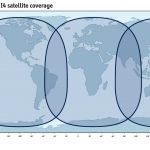 The Internet Hole - You might wonder why we haven’t been posting to the blog the last few days. It turns out that if you travel far enough south, you will, eventually, reach a region of earth with no satellite coverage. It also happens that as you near the edge of the internet hole, the bandwidth that you have […]
The Internet Hole - You might wonder why we haven’t been posting to the blog the last few days. It turns out that if you travel far enough south, you will, eventually, reach a region of earth with no satellite coverage. It also happens that as you near the edge of the internet hole, the bandwidth that you have […]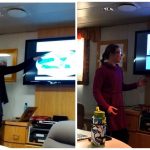 Of Scientists and Seminars… - What do a bunch of scientists on a research cruise in the Southern Ocean en route to Antarctica do when they aren’t staring into microscopes, analyzing data, or preparing their next experiment? Well, a seminar series, of course! We’ve started “the Science Café” – a daily seminar series where one of us will give a […]
Of Scientists and Seminars… - What do a bunch of scientists on a research cruise in the Southern Ocean en route to Antarctica do when they aren’t staring into microscopes, analyzing data, or preparing their next experiment? Well, a seminar series, of course! We’ve started “the Science Café” – a daily seminar series where one of us will give a […]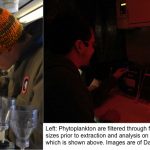 Antarctic phytoplankton: How many are out there? - The focus on this cruise has been phytoplankton, and one of their identifying features is the presence of chlorophyll. The very same pigment that makes the plants you see outside a bright green. Therefore, measuring the amount of chlorophyll fluorescence gives us a sense of the abundance of this phytoplankton in the water. Measuring chlorophyll […]
Antarctic phytoplankton: How many are out there? - The focus on this cruise has been phytoplankton, and one of their identifying features is the presence of chlorophyll. The very same pigment that makes the plants you see outside a bright green. Therefore, measuring the amount of chlorophyll fluorescence gives us a sense of the abundance of this phytoplankton in the water. Measuring chlorophyll […]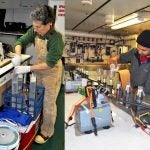 Filtering and filtering and filtering……. - After the niskin rosette come on board, how do we collect floating phytoplankton? We use techniques that pull those plankton out of the water. One very common method is filtration. We filter water onto small round filters, collect the plankton on those filters and then discard the “empty” water. This is such a great way […]
Filtering and filtering and filtering……. - After the niskin rosette come on board, how do we collect floating phytoplankton? We use techniques that pull those plankton out of the water. One very common method is filtration. We filter water onto small round filters, collect the plankton on those filters and then discard the “empty” water. This is such a great way […]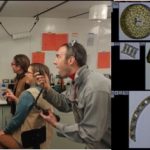 Meet FlowCam: The N.B. Palmer Creature Feature - Here in the Southern Ocean, we are surrounded by ice and abundant ‘charismatic megafauna’ including seals, whales, and penguins. We think phytoplankton are pretty darn charismatic too given their capacity to fuel this diverse and flourishing Antarctic marine ecosystem. Fortunately, we have an instrument on board that allows us to image the diverse and stunningly […]
Meet FlowCam: The N.B. Palmer Creature Feature - Here in the Southern Ocean, we are surrounded by ice and abundant ‘charismatic megafauna’ including seals, whales, and penguins. We think phytoplankton are pretty darn charismatic too given their capacity to fuel this diverse and flourishing Antarctic marine ecosystem. Fortunately, we have an instrument on board that allows us to image the diverse and stunningly […]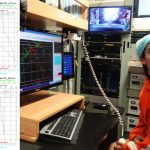 Science support on the Palmer - We couldn’t do all this sampling without the amazing support staff available on this ship. The ship’s crew get us to our sample locations, keep everything working and keep us fed and comfortable. The MTs (Marine Technicians) get our sampling equipment in and out of the water and keep it functioning. Meanwhile, the ETs (Electronics […]
Science support on the Palmer - We couldn’t do all this sampling without the amazing support staff available on this ship. The ship’s crew get us to our sample locations, keep everything working and keep us fed and comfortable. The MTs (Marine Technicians) get our sampling equipment in and out of the water and keep it functioning. Meanwhile, the ETs (Electronics […]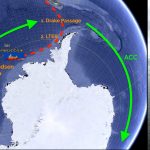 Traversing the Southern Ocean - If you’ve been following our journey, you’ve probably noticed that our cruise track has taken us across several lines of longitude and many time zones. In total, we will be setting back our clocks eight times while we traverse the Southern Ocean! Why would we subject ourselves to such chaos? The answer lies in the […]
Traversing the Southern Ocean - If you’ve been following our journey, you’ve probably noticed that our cruise track has taken us across several lines of longitude and many time zones. In total, we will be setting back our clocks eight times while we traverse the Southern Ocean! Why would we subject ourselves to such chaos? The answer lies in the […]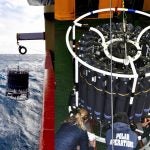 Deep water on the high seas - When you are rocking and rolling on a ship with large swells and high winds, it can be difficult just to collect water from the surface, much less from the ocean’s depths. On this cruise, we are using a CTD rosette to sample water below the ocean’s surface. The rosette has two important components. The […]
Deep water on the high seas - When you are rocking and rolling on a ship with large swells and high winds, it can be difficult just to collect water from the surface, much less from the ocean’s depths. On this cruise, we are using a CTD rosette to sample water below the ocean’s surface. The rosette has two important components. The […]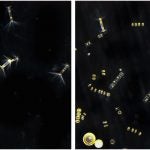 The inshore and offshore lives of diatoms - We are now entering the open waters of the Amundsen Sea after a few days sampling in the beautiful fjords of the West Antarctic Peninsula. Above are two photographs of diatom communities from two of our sampling stations. The image on the left depicts diatoms we found in one of the open ocean sites while […]
The inshore and offshore lives of diatoms - We are now entering the open waters of the Amundsen Sea after a few days sampling in the beautiful fjords of the West Antarctic Peninsula. Above are two photographs of diatom communities from two of our sampling stations. The image on the left depicts diatoms we found in one of the open ocean sites while […]

